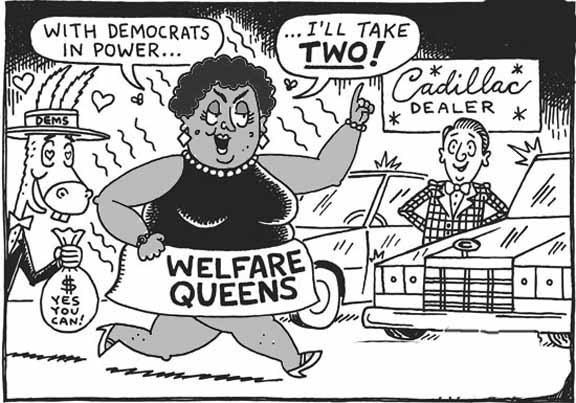 | ||
"Welfare queen" is a pejorative term used in the U.S. to refer to women who allegedly collect excessive welfare payments through fraud or manipulation. Reporting on welfare fraud began during the early 1960s, appearing in general-interest magazines such as Readers Digest. The term "welfare queen" dates from a 1974 Jet magazine story.
Contents
Since then, the phrase has remained a stigmatizing label and is most often directed toward black, single mothers. Although women in the U.S. could no longer stay on welfare indefinitely after the federal government launched the Temporary Assistance for Needy Families (TANF) program in 1996, the term continues to be a trope in the American dialogue on poverty.
Origin
The idea of welfare fraud goes back to the early-1960s, when the majority of known offenders were male. Despite this, many journalistic exposés were published at the time on those who would come to be known as welfare queens. Readers Digest and Look magazine published sensational stories about mothers gaming the system. Additionally, Ronald Reagan employed the trope of the "Welfare Queen" in order to rally support for reform of the welfare system. During his initial bid for the Republican nomination in 1976, and again in 1980, Reagan constantly made reference to the "Welfare Queen" at his campaign rallies. Some of these stories, and some that followed into the 1990s, focused on female welfare recipients engaged in behavior counter-productive to eventual financial independence such as having children out of wedlock, using AFDC money to buy drugs, or showing little desire to work. These women were understood to be social parasites, draining society of valuable resources while engaging in self damaging behavior. Despite these early appearances of the "Welfare Queen" icon, stories about able-bodied men collecting welfare continued to dominate discourse until the 1970s, at which point women became the main focus of welfare fraud stories.
The term was coined in 1974, either by George Bliss of the Chicago Tribune in his articles about Linda Taylor, or by Jet Magazine. Neither publication credits the other in their "Welfare Queen" stories of that year.
Taylor was ultimately charged with committing $8,000 in fraud and having four aliases. She was convicted of illegally obtaining 23 welfare checks using two aliases. She was sentenced to two to six years in prison. During the same decade, Taylor was additionally investigated for murder, kidnapping, and baby trafficking. Stories of her activities were used by Ronald Reagan, starting with his 1976 presidential campaign, to illustrate his criticisms of social programs in the United States.
In political discourse
The term "welfare queen" became a catchphrase during political dialogue of the 1980s and 1990s. The term came under criticism for its supposed use as a political tool and for its derogatory connotations. Criticism focused on the fact that individuals committing welfare fraud were, in reality, a very small percentage of those legitimately receiving welfare. Use of the term was also seen as an attempt to stereotype recipients in order to undermine public support for AFDC.
The welfare queen idea became an integral part of a larger discourse on welfare reform, especially during the bipartisan effort to reform the welfare system under Bill Clinton. Anti-welfare advocates ended AFDC in 1996 and overhauled the system with the introduction of TANF. Despite the new system’s time-limits, the welfare queen legacy has endured and continues to shape public perception.
Gender and racial stereotypes
Political scientist Franklin Gilliam has argued that the welfare queen stereotype has roots in both race and gender:
"While poor women of all races get blamed for their impoverished condition, African-American women commit the most egregious violations of American values. This story line taps into stereotypes about both women (uncontrolled sexuality) and African-Americans (laziness)."
The media's image of poverty shifted from focusing on the plight of white Appalachian farmers and on the factory closings in the 1960s to a more racially divisive and negative image of poor blacks in urban areas. All of this, according to political scientist Martin Gilens, led to the American public dramatically overestimating the percentage of African-Americans in poverty. By 1973, in magazine pictures depicting welfare recipients, 75% featured African Americans even though African Americans made up only 35% of welfare recipients and only 12.8% of the US population. In 2016, African Americans made up 39.6% of welfare recipients, and, in 2015, African Americans made up 13.3% of the United States population. However, in a study conducted by Van Doorn he suggested the media repeatedly shows a relationship between lazy, black, and poor suggesting why some Americans are opposed to welfare programs.
From the 1970s onwards, women became the predominant face of poverty. In a 1999 study by Franklin Gilliam that examined people's attitudes on race, gender, and the media, an eleven-minute news clip featuring one of two stories on welfare was shown to two groups of participants. Each story on welfare had a different recipient—one was a white woman and the other was a black woman. The results showed that people were extremely accurate in their recall of the race and gender of the black female welfare recipient in comparison to those who saw the story with the white female welfare recipient. This outcome confirmed that this unbalanced narrative of gender and race had become a standard cultural bias and that Americans often made implicit associations between race, gender, and poverty.
